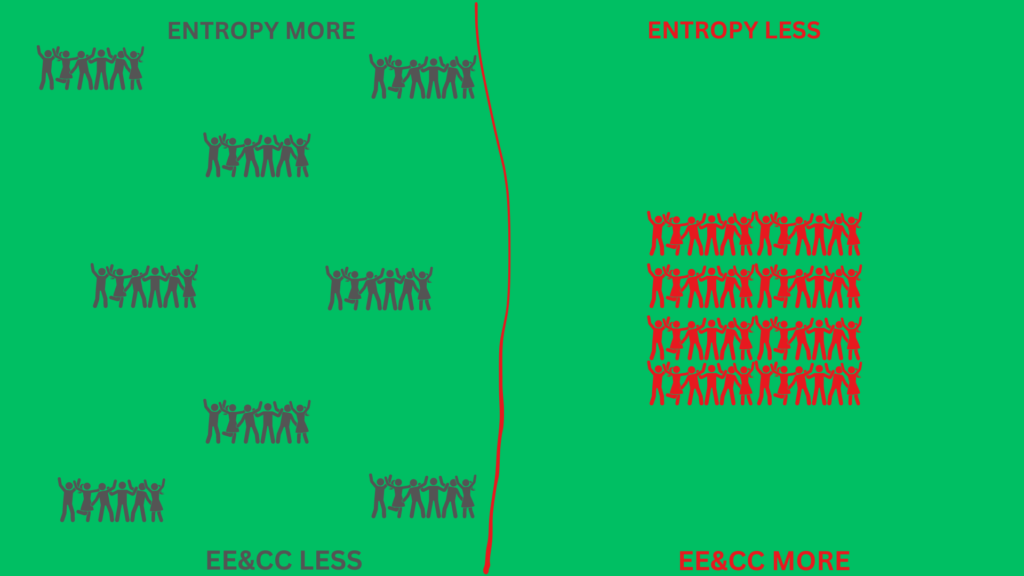
POPULATION BOON OR BANE EE&CC WAY OF ANALYSIS
EE&CC theories have instilled in me a sense of rightful and systematic thinking, both in my personal and professional life. Unfortunately, some of my acquaintances, lacking understanding of my sincerity and foresight, have occasionally misunderstood and criticized me. However, once I embraced the ideas of EE&CC, I began engaging in self-analysis of the most pressing issues plaguing our planet, Earth. One such question that has occupied my thoughts is whether population is a boon or a bane.
I began engaging in profound and introspective thinking for extended periods of time. During this process, I was reminded of a speech delivered by our late Prime Minister, Smt. Indira Gandhi, at the Stockholm Conference in 1972. Her words, which I quote below, resonated with me deeply.
“It is an over-simplification to blame all the world’s problems on increasing population. Countries with but a small fraction of the world’s population consume the bulk of the world’s production of minerals, fossil fuels and so on. Thus we see that when it comes to the depletion of natural resources and environmental pollution, the increase of one inhabitant in an affluent country, at his level of living, is equivalent to an increase of many Asians, Africans or Latin Americans at their current material levels of living”.
The actual consumption of a human being is undoubtedly finite; however, vast amounts of resources are being squandered and rendered non-productive in the name of consumption. This wastage manifests itself in various forms, such as emissions, theft, and underutilized assets. By minimizing this wastage and effectively utilizing spare capacity, resources can be channeled towards genuine human development. This can be achieved through strategic planning that aims to increase residential densities while providing shared facilities. Such an approach has the potential to transform population growth into a boon. Additionally, unnecessary and unplanned encroachment upon our supporting ecosystems can be minimized. It is important to recognize that ecosystems serve crucial functions, including provision, regulation, support, and cultural preservation, all of which are vital for human activities(MA 2000) within cities that function as hubs for human development and innovation .
Microorganisms play a vital role in maintaining the equilibrium of our planet, Earth. Whether they exist in our gut or in the roots of plants, these microorganisms contribute significantly to sustaining life. However, when climate changes occur and ecosystems face disruption, these microorganisms can also face extinction. A notable example is the disappearance of arsenic-fixing bacteria, which has led to arsenic poisoning in rice cultivation. Even the beneficial gut bacteria in human beings can be lost due to unsustainable food practices. As a result, our planet is becoming more acidic, whereas a slightly alkaline environment is conducive to our well-being. It is imperative that we address this acidification process systematically, taking into consideration its impact on soil, oceans, animals, and human beings.
Environmental Efficiency and Carrying Capacity are intrinsically connected, much like two sides of a coin. Environmental Efficiency holds the key to sustainability in our human-centric world. By improving Environmental Efficiency, we can strive to achieve the essential goal of a Circular Economy, especially crucial in the post-pandemic era. Positive Carrying Capacity, measured in ton value, contributes significantly to enhancing Environmental Efficiency.
Regrettably, it is disheartening to acknowledge that our world is currently exceeding its limits, driven by escalating consumption patterns that surpass the Earth’s regenerative capacity. Dr. Mathis Wackernagel’s Global Footprint Calculations reveal that our consumption is equivalent to 1.75 Earths, despite having only one Earth available to us. This overshooting of resources is a pressing issue that demands immediate attention and action.
In an environmentally efficient human development center, people experience happiness through wellness, skill development, and profitability. This is achieved through various means, including the adoption of non-motorized transport systems (NMTS) promoting good food habits, and reducing emissions. By saving fossil fuels and time, individuals and communities can reap financial benefits, resulting in increased per capita income.
Furthermore, when urban policies are designed to prioritize equity, it fosters higher levels of environmental efficiency. This improved environmental efficiency can be measured by the concept of ‘may value’, reflecting the holistic value created by sustainable practices and equitable policies.
Returning to the thought-provoking question, “Is population a boon or bane?” I have arrived at the understanding that when governments prioritize an Environmental Efficiency Approach in shaping national policies, population becomes a boon. This approach ensures that the population’s human development achievements are optimized while considering their consumption practices in an environmentally efficient manner.
In environmentally efficient habitats, people can thrive and prosper, leading to increased innovation. It is important to note that individuals who are constantly burdened by the day-to-day challenges posed by stressful environmental conditions may not have the time or resources to engage in innovative thinking. However, in an environment that fosters sustainability and efficiency, more and more innovations can emerge. These innovations, in turn, lead to greater convenience and benefits for the population as a whole.
Summary in Practical Lines:
Prioritising human welfare and the well-being of ecosystems is crucial in our human-centric world. Neglecting our supporting ecosystems can lead to chaos and sufferings, causing a boomerang effect.
Instead of focusing solely on population numbers, we should emphasize population concentration for a sustainable Earth in the 21st century. Researching and implementing technological advancements and possibilities of this era can help achieve higher population concentrations.
Increasing residential densities in a scientifically informed manner contributes to sustainability in terms of Environmental Efficiency (EE) and Carrying Capacity (CC), which are interconnected.
Accommodating more people in an environmentally efficient setup provides them with convenience, accessibility, variety, and diversity, leading to increased community choices and overall happiness.
Peaceful and content minds are fertile ground for innovation, as they actively seek ways to enhance their own happiness and well-being of the humanity.
To delve deeper into EE&CC theories and explore ‘may&ton’ values, please visit our website: www.centreforenvironmentalefficiency.org.
Let us join hands in the pursuit of higher Environmental Efficiency by fostering a culture of sharing, caring, and embracing robust and transparent Environmental Management Systems. Technological innovations can play a crucial role in enhancing these systems, ensuring their effectiveness and reliability. Together, we can work towards a future where our actions align with rightful environmental practices, leading to a more sustainable and prosperous world.
Note: EE&CC stands for Environmental Efficiency and Carrying Capacity. Environmental Efficiency is determined through an Output/Input approach, while Carrying Capacity is assessed using a Capacity/Consumption approach. These concepts encompass various factors, including the Human Development Index (HDI) and Inequality Adjusted Human Development Index (IHDI) provided by the UNDP, as well as the Bio-capacity and Ecological Footprint metrics developed by the Global Footprint Network under the guidance of Dr. Mathis Wackernagel.
Dr May Mathew
Founder
This article is originally published in the medium page of the Centre for Environmental Efficiency as per the following link:










